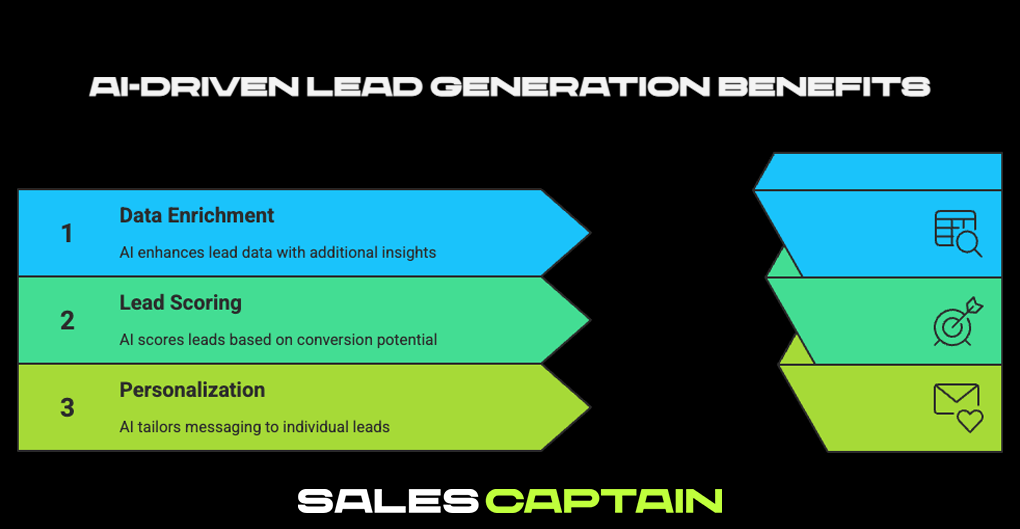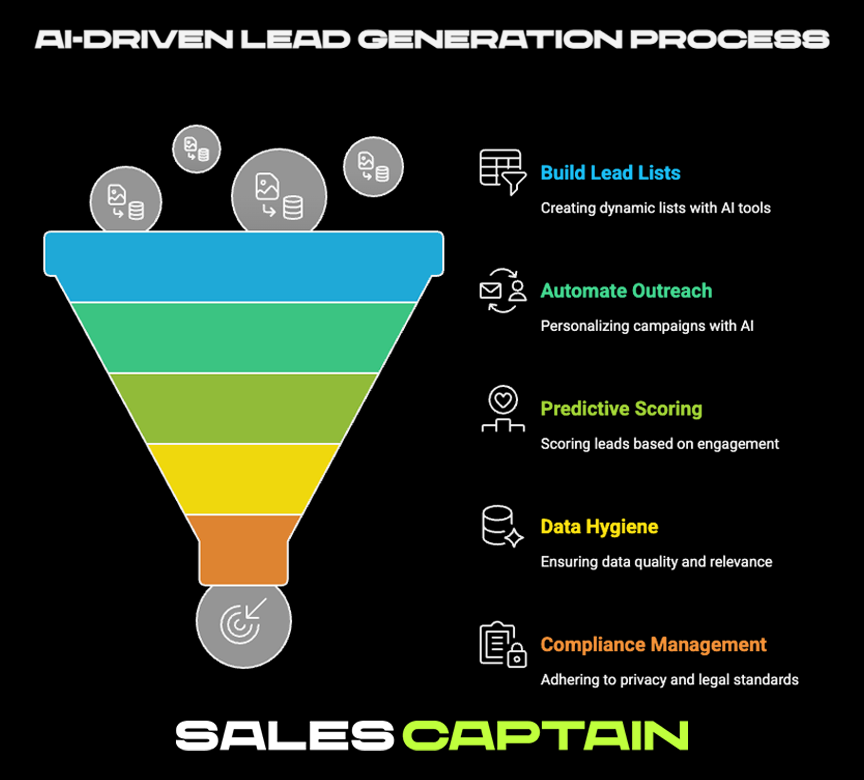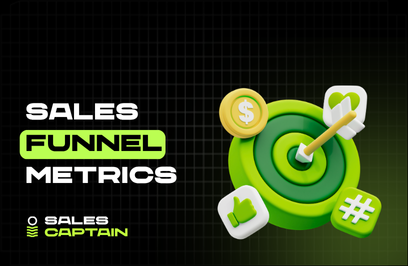

AI B2B Lead Generation: Build a smarter, faster, signal-driven pipeline


AI B2B lead generation turns outbound into a precise, repeatable system. Instead of guessing who to contact, you combine clean data, real intent signals, and automation to source, score, and personalize at scale. The result is fewer wasted touches, faster cycles, and a pipeline that improves with every run. This guide shows how to pick the right tools, design workflows, and measure what actually drives revenue.
Understanding AI in B2B Lead Generation
Defining AI-Powered Lead Generation
AI-powered lead generation uses machine learning, natural language processing, and automation to identify, engage, and qualify prospects at scale. It pulls in signals, firmographics, intent data, and past outreach behavior and turns chaos into conversion paths.
It’s not just scraping leads or running a chatbot. It’s programmatic prospecting. Think of it as building a GTM system that gets smarter as it runs.
Instead of asking a rep to guess which prospects to reach out to, AI scans millions of data points and says, “These people are likely to say yes. Here’s why. Here’s how to reach them.”
It makes outbound scientific. Cold outreach that operates like paid acquisition, with performance benchmarks, rapid iteration, and rigorous feedback loops.
Importance of AI in Today's Market
B2B buyers don’t respond to spray-and-pray anymore. They expect speed, context, and relevance. That’s the only way to earn attention inside their inbox or feed.
AI makes that possible. It’s made outbound cheap, scalable, and signal-driven. You don’t need a room full of SDRs burning time on manual research. A technical operator can now run sophisticated outbound that feels 1:1, but behaves like performance marketing.
With the SaaS market saturated and buyer attention fragmented, AI isn’t just a nice-to-have. It's the engine behind any modern demand strategy. If you're not adapting, you're burning budget competing against algorithms with guesswork.
Sales, marketing, ops, it’s one growth team now. And AI is the backbone.
Key Benefits of AI for Lead Generation

Enhanced Efficiency with Automation
Manual prospecting workflows were never built to scale. AI flips that. Instead of copy-pasting LinkedIn profiles into a spreadsheet, you're auto-enriching contact data, syncing CRMs, and triggering workflow logic on autopilot.
AI doesn't replace human creativity, but it handles the repetitive, menial tasks faster and error-free. That unlocks time for strategy, copy, offer testing, and refinement. The levers that actually move the pithe peline.
Your team stays lean, your campaigns move faster, and your CAC drops. That’s the real win here.
Improved Lead Quality through Data Analysis
Not all leads should be treated equally. AI filters out the noise.
It analyzes behavioral, firmographic, and engagement data to surface leads most likely to convert. You're no longer guessing at ICP fit or lead stage based on job title or company size. Now you're scoring based on contextual data, hiring signals, tech stack changes, funding announcements, and more.
The result: reps stop wasting energy on junk leads. They talk to qualified buyers who actually need what you’re selling.
It’s precision targeting, built into every step of the motion.
Hyper-Personalization Across Engagement Channels
One-size-fits-all messaging gets deleted. AI enables personalization at a scale that wasn’t humanly possible a few years ago.
Emails adjust tone, offer, and structure based on persona and industry. LinkedIn DMs reference recent company news. Landing pages auto-personalize for the segment. Every channel feels tailored, because it is.
And here's the kicker: it’s driven by data, not gut instinct. That’s how you get personalized outbound that performs like inbound.
Framework for Implementing AI in Lead Generation
Assessing Business Needs and Goals
Start with clarity. What gaps are you solving with AI?
Is your team struggling to source leads? Are reps wasting hours qualifying the wrong prospects? Is conversion lagging due to irrelevant messaging?
Before you implement a tool, define the GTM system you’re building. Where are the bottlenecks? What data do you already have? What are your short- and long-term pipeline goals?
Without that clarity, you’ll end up duct-taping tools together and diluting results.
Choosing the Right AI Tools
Once you’ve mapped the GTM gaps, match them with the right tools. Don’t fall into the shiny object trap. Choose based on need, not trend.
A few filters to guide selection:
- Does the tool integrate cleanly into your workflow?
- Can it scale as you grow?
- Does it support feedback loops (data in, performance out)?
- Is it operator-friendly, or will it require months of onboarding?
For sourcing and enrichment, tools like Clay offer unmatched flexibility. The bonus? You get 3,000 free credits from that link.
Evaluate tools based on impact, not features.
Training Teams on New Workflows
Tools are easy. Adoption isn’t.
Rolling out AI means shifting how your team thinks about workflow. SDRs become operators. Marketers become system architects. No more copy-paste prospecting. No more batch-blast outreach.
You’ll need to train for:
- Data hygiene
- Prompt engineering
- Workflow logic
- API literacy (if applicable)
Make training part of onboarding and iterate on it weekly with actual use cases. If your team doesn't adapt, the tech’s useless.
Measuring and Optimizing Results
Set quantifiable KPIs early. Think response rates, conversion by segment, touchpoint engagement, deal velocity by cohort, etc.
Regularly audit performance by workflow. Which signals predict success? Which ones don't? Are there points in the funnel that consistently underperform?
Optimization isn’t about guessing. It’s about feedback loops and iteration. This is how AI becomes compound interest for your GTM system.
Tools for Effective AI-Driven Lead Generation
Top AI Solutions to Consider
There’s no perfect stack. But some tools consistently stand out:
- 🧠 Clay: Blend data sources, enrich leads, and trigger workflows in real time. Think of it as a programmable lead engine.
- 📨 Apollo.io: Data + engagement platform with sequencing built-in.
- 🧪 6sense: Intent data and predictive analytics to surface in-market accounts.
- 🔍 ZoomInfo + Chorus.ai: Great for enrichment and conversation intelligence, if you're operating at scale.
- 🤖 Lavender or Smartwriter: For AI-assisted email copy personalization.
Again, don’t stack tools for the sake of it. Stack based on need.
Strategies for Leveraging AI in Lead Generation

Building Targeted Lead Lists
Generic lists don’t cut it. AI lets you build highly dynamic lead lists filtered by exact signals: tech stack, headcount growth, recent hiring, funding rounds, and more.
Plug in your ICP, pull from multiple sources (LinkedIn, Crunchbase, job boards), and use tools like Clay to automatically enrich, deduplicate, and validate.
No more static CSVs. These are living, breathing lists that update with your market.
Automating Outreach Campaigns
Stop writing every cold email by hand. Use AI to build modular campaigns that adapt based on persona, stage, objection, or behavior.
Set conditions: if they opened but didn’t reply, send a different follow-up. If they clicked a link, send case studies.
You’re no longer running email blasts. You’re running personalized flows that evolve in real time.
With the right setup, outreach becomes performance marketing, with control, scale, and agility.
Using Predictive Analytics for Lead Scoring
AI doesn't just help with who to contact. It tells you when, why, and in what sequence.
Predictive scoring models look beyond job title. They factor in engagement patterns, buyer signals, and intent data.
Scoring lets you segment hot leads from cold leads efficiently. Prioritize reps' time. Align marketing and sales around shared definitions of “ready.”
And when combined with AI-driven outreach, that scoring data feeds directly back into the workflow. The loop tightens. The playbook sharpens. Conversions improve.
Done well, AI isn’t just a layer on top of outbound. It’s a rewiring of how GTM functions.
Outbound agencies like SalesCaptain are already building full-funnel systems around AI, automated, data-rich, conversion-optimized GTM machines. Not cold email monkeys. Architects.
And that’s where this space is headed.## Overcoming Challenges in AI Lead Generation
Addressing Data Quality Issues
AI doesn’t fix bad data. It amplifies it.
If your source data is noisy, outdated, or inconsistent, AI algorithms will generate misleading insights, score the wrong leads, or trigger irrelevant workflows. Garbage in, garbage out, but faster.
The fix? Build data hygiene into every step. That means deduping, validating contact info, enriching with fresh signals, and filtering out low-quality records before they hit your system. Tools help, but process beats software. Create infrastructure that keeps your dataset clean over time.
Also, don’t over-focus on firmographics. The most useful data tends to be dynamic: recent hires, product launches, and intent signals. Quality isn’t just accuracy. Its relevance.
Managing Privacy and Compliance Concerns
AI and automation don’t get a free pass around GDPR or CAN-SPAM.
Scraping data without consent or flooding inboxes at scale will get you flagged, or worse. And with AI’s ability to move fast, mistakes scale too.
Stay compliant by embedding guardrails into workflows. Validate opt-in status. Use verified contact data. Respect frequency caps. Customize based on local laws if you’re targeting globally.
If you’re using AI to write cold emails, review emails. Yes, AI can draft it, but your team’s responsible for what gets sent. Transparency and human oversight aren’t optional.
Smart outbound isn’t spammy outbound. The best GTM systems balance automation with trust.
Navigating Lack of In-House Expertise
Most teams weren’t built for this new wave of go-to-market. You need operators who can read docs, plug into APIs, build logic flows, and do data mapping, all before lunch.
AI tools sound simple, but running them well. That’s technical work. And too many teams throw SDRs or marketers into the deep end, assuming they’ll figure it out.
You’ve got two options:
- Train internally. Upskill roles to manage workflows, prompts, data flows, and tool stacks.
- Bring in outside help. Outbound agencies like SalesCaptain aren’t just writing emails; they’re building GTM infrastructure with AI at the core.
Either way, don’t assume your existing team can run a modern AI-powered outbound motion without training. AI isn’t a push-button tactic. It’s a system.
Metrics for Success in AI Lead Generation
Key Performance Indicators to Track
Forget vanity metrics like email open rates. When AI runs your outbound, you can track deeper KPIs that tie to impact:
- Response rate by persona or segment
- Lead-to-opportunity conversion
- Time-to-first-touchpoint
- Predictive lead score accuracy
- Channel-level performance (email, LinkedIn, etc.)
- Enrichment coverage and freshness
- Workflow execution success/failure rate
This is where AI flips outbound into a measurable system. Every touchpoint becomes a data point. Every drop-off shows you how to optimize pipeline flow.
If you’re not tracking KPIs within your AI workflows, you’re just guessing faster.
Analyzing ROI from AI Implementations
Measuring ROI on AI isn’t just about spend versus revenue. It’s about efficiency gains. How much faster is your team moving? How many fewer hours does pipeline creation require? How much better is your targeting?
Here’s what to look at:
- CAC drops after AI implementation
- Lead velocity vs. prior manual processes
- Time savings in prospecting and list building
- Lift in conversion rates post-personalization
- Lower reliance on headcount (fewer SDRs, more output)
You’ll get the clearest ROI signal when you treat AI as part of your GTM system, not a one-off play. It's not just about cost savings. It's about quality motion at scale.
Common Mistakes to Avoid in AI Lead Generation
Misunderstanding AI Capabilities
AI isn't magic. It doesn't “know” your business. It processes inputs and follows logic.
Expecting it to write high-performing copy, find the perfect ICP, or solve low conversion by itself is a setup for failure. The system's only as smart as the signals and structure you give it.
A common mistake? Hitting "generate email" and sending without edits. AI-generated content needs direction. Prompt quality determines output quality.
Use AI for what it’s good at: fast research, scalable personalization, data-driven scoring. But guide it with strategy.
Neglecting Data Integrity and Accuracy
If your inputs are shallow or wrong, your entire motion underperforms.
Companies often skip enrichment, map titles incorrectly, or trust tool-generated personas without verifying. Then they blame AI for poor results.
Make data integrity a non-negotiable. Validate sources. Review enrichment. Clean duplicates, dead emails, and low-quality records. Automate those checks if you can.
It’s one thing to message a lead who’s a bad fit. It’s another to burn your domain score and ruin email deliverability because bad data slipped through. That’s expensive.
Failure to Adapt Strategies Based on Insights
AI gives you feedback loops. But too many teams ignore the signals and keep running the same play.
If your response rate is low in one industry or persona, switch it up. If predictive scoring flags certain accounts as low-fit, stop nurturing them.
AI works best when you iterate. Build workflows that adapt, change messaging by performance, tweak list logic based on reply patterns, and adjust scoring as deal data rolls in.
If you’re not evolving your strategy based on what the system’s telling you, you’re leaving conversion upside down on the table.
Future Trends in B2B Lead Generation
Emerging Technologies Shaping Lead Generation
The line between sales, marketing, and ops is fading, and tech’s driving it.
Expect more tools that combine outreach, enrichment, scoring, and engagement into one fluid motion. Think real-time lead list updates based on trigger data. AI copilots for reps that suggest responses or next-best actions. Workflow engines that adjust in-flight based on lead behavior.
Also, voice and video are coming. AI-written video messages, personalized screen recordings, pitch decks generated on the fly based on use case. All automated. All tailored.
But the real shift? GTM is becoming deeply programmable. You’re not “using tools.” You’re building go-to-market machines.
Predictions for AI in Marketing
A few bets worth watching:
- Personalization gets deeper and more contextual. Not just {{first_name}} but AI-generated messaging tuned to buyer psychology.
- AI replaces 80% of SDR functions. Data research, outreach, and intro calls become programmatic.
- Marketers become revenue operators. Owning outbound, managing workflows, and analyzing pipeline metrics.
- Agencies shift from service to system. Like SalesCaptain, new-age outbound shops offer ready-made AI GTM stacks, not just campaigns.
Most teams will either become AI-native or get left tweaking subject lines while the competition automates entire funnels.
FAQs
AI in lead generation means using algorithms and logic, not manual labor, to find, qualify, and engage leads. It identifies patterns across massive datasets: job changes, funding events, tech stack shifts, site behavior, and outreach history.
It doesn’t replace humans. It lets a lean team move at the speed of data.
Real AI lead gen isn’t scraping contacts or dumping them into sequences. It’s building systems:
- Smart sourcing
- Programmatic personalization
- Trigger-based outreach
- Feedback loops that refine targeting over time
It's outbound, scientifically optimized.
Start by tracking outcomes, not just outputs. AI's impact shows up in:
- Faster pipeline creation
- Lower cost per lead
- Higher reply and meeting rates
- Time saved on prospecting
- Increased lead-to-opportunity conversion
Calculate ROI like this:
(value of closed-won from AI workflows + time/cost savings) ÷ total invested in tools + setup.
And here’s the kicker, AI’s true ROI compounds over time. Each feedback loop makes the system better. Each campaign teaches the next. The more you run it, the smarter it gets.
A few big ones:
- “It’s plug-and-play.”
Nope. The best results come from smart workflows, clean data, and technical operators. Not default settings and hope. - “It replaces creativity.”
False. AI handles repetition. Humans still own story, strategy, and nuance. Think: AI writes the first draft. You tune it. - “It’s just for enterprise.”
Wrong again. AI has democratized outbound. Small teams can look huge with the right system. - “It’s only for email.”
Lead gen now spans channels. AI personalizes across DM, landing pages, voice notes, and even video scripts.
Believing these myths keeps teams stuck writing 100 cold emails by hand.
If you’re thoughtful? 1-2 weeks for a lightweight, working system.
Using a modular tool like Clay, you can spin up workflows in hours, especially if you stick to one persona or segment.
The longer cycles happen when:
- Your ICP isn’t defined
- Your workflows aren’t mapped
- You’re over-buying tech without a use case
- Your team lacks a technical operator
Pro tip: Start small. Prove fast. Expand from success. Don’t try to automate your entire GTM in one go.
Not full-stack dev skills, but you do need operator chops.
Running AI outbound requires:
- Understanding logic flows (if/then, triggers, filters)
- Working across multiple tools (data source, messaging, CRM)
- Editing prompt templates or variables
- Reading docs and troubleshooting when things break
If your team doesn’t have that muscle, hire for it or bring in help.
Agencies like SalesCaptain specialize in this; they’re not pitching lists, they’re building GTM infrastructure.
You don’t need to code. But you do need to think like a system builder. That’s the new outbound muscle.
RELATED ARTICLES
Check out more articles on our blog!
RELATED ARTICLES
Lorem ipsum dolor sit amet, consectetuer adipiscing elit, sed diam nonummy nibh euismod tincidunt ut laoreet dolore magna aliquam erat volutpat.




.jpg)
.png)




